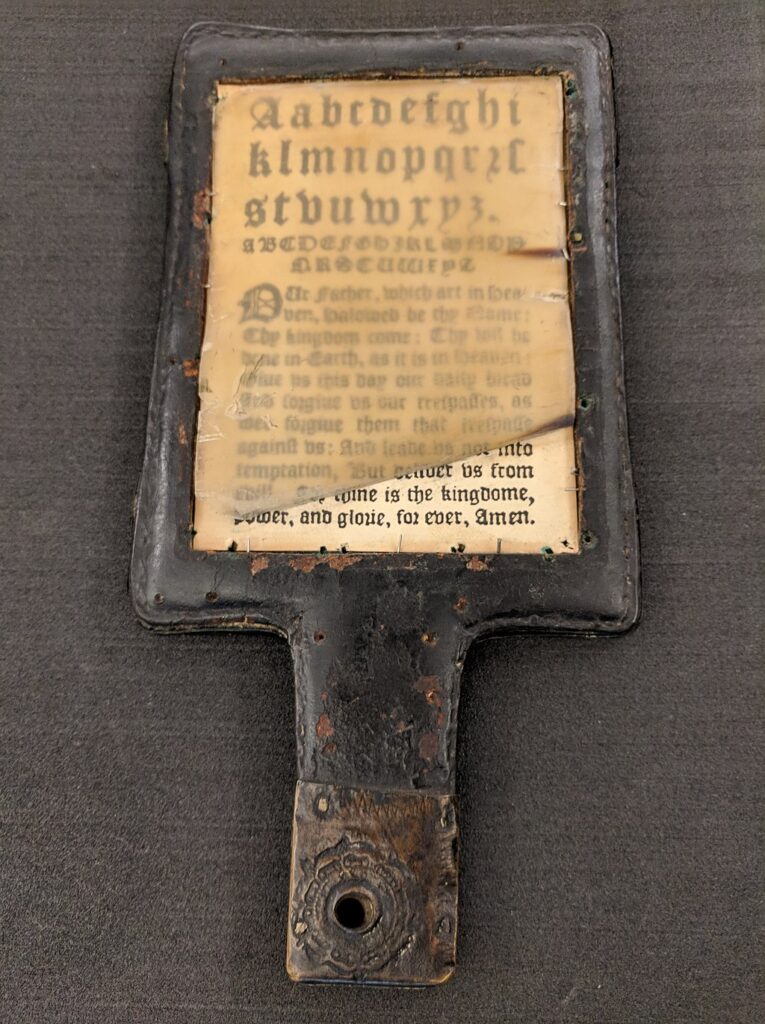Glossary
Hornbook

Other languages
- Dutch: haneboek, leesplank
- French: abécédaire, charte, carte, palette, tablette
- German: Buchstabentafel, ABC-Täfelchen
- Italian: tavoletta, carta, tolella
- Spanish: cartilla
Material form
Single-sheet printSubject
Knowledge and skills, Religion and moralityDescription
Common in England, the Netherlands and many other European countries from the 16th to 19th centuries, hornbooks were educational material for children, consisting of a wooden board with a handle, with a single sheet of print on them. Typically, these sheets contained either the alphabet, the numeric system and/or the Lord’s Prayer. In the 18th century such hornbooks were often referred to as ‘hanenboeken’ (rooster books, see catechism primer) in the Netherlands, named after the Abc booklets with roosters.
In England, paper versions of hornbooks were published from the 18th century onward: battledores, consisting of a sheet printed on both sides and shaped in a form similar to that of a hornbook. Battledores were usually folded into three; they contained the alphabet, syllables, and also images and short pieces of religious or secular text.
In Spain the cartilla contained an alphabet, a syllabary, prayers and catechetical texts, a guide for mass and a multiplication table.
In Italy there is indirect evidence of the use of wooden boards with the alphabet, either painted or printed on a sheet that was pasted to the board. For example, in Pietro da Talada’s painting Madonna with Child in the Santa Maria di Capraia church in Pieve Fosciana (c. 1460), Jesus is depicted holding a hornbook with the alphabet and a few syllables. No actual specimens have been retrieved, neither of the boards nor of this kind of printed sheet.
Related terms
battledore, abecedarium, catechism primer, children’s book and schoolbook
Sources
P. Buijnsters and L. Buijnsters-Smets, Bibliografie van Nederlandse school- en kinderboeken 1700-1800 (Zwolle: Waanders, 1997).
P. Buijnsters, Nederlandse kinderboeken uit de achttiende eeuw (Amsterdam: Querido’s Uitgeverij, 1989).
L. Carnelos and E. Marazzi, ‘Children and Cheap Print from a Transnational Perspective’, Quaerendo 51 (2021), 189-215.
B. Folmsbee, A Little History of the Horn-book (London: F. Stevens & Brown, 1983 [1942]).
V. Infantes, De las primeras letras: cartillas españolas para enseñar a leer de los ss. XV y XVI (Salamanca: Ediciones Universidad de Salamanca, 1998).
V. Infantes, De las primeras letras: cartillas españolas para enseñar a leer del siglo XVII y XVIII (Salamanca: Ediciones Universidad de Salamanca, 2003).
‘Hornbook’, in: A. Kent, J.E. Daily, H. Lancour (eds.), Encyclopedia of Library and Information Science, Vol. 11 (New York: Dekker, 1974).
P. Lucchi, ‘La Santacroce, il Salterio e il Babuino: libri per imparare a leggere nel primo secolo della stampa’, Quaderni storici 13 (1978), nr. 38, 593-630.
A. McShane, ‘Ballads and Broadsides’, in: J. Raymond (ed.), The Oxford History of Popular Print Culture, Vol. 1 (Oxford: Oxford University Press, 2011), 339-362.
S. Minuzzi, Antonio Bosio artigiano di testi e immagini nella Venezia del Seicento (Milan: FrancoAngeli, 2009), 179-188.
A. Serrano Dura, A transnational study of eighteenth-century English street literature and Spanish literatura de cordel: Cluer Dicey and Augustin Laborda, Tesis Doctoral (Valencia: Universidad Católica de Valencia, 2021). http://hdl.handle.net/20.500.12466/2174
A.W. Tuer, A History of the Horn-Book (London: The Leadenhall Press, 1897).
A. Willemsen, Back to the Schoolyard. The Daily Practice of Medieval and Renaissance Education (Turnhout: Brepols, 2008), 52-54.

